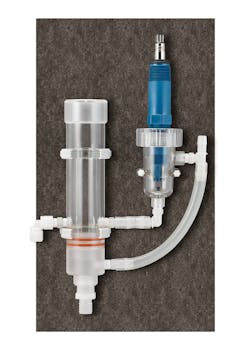Solving pH sensor challenges in high-purity water process operations
Process industries depend on water quality monitoring and control to protect their equipment from excessive wear and tear in high-pressure, high-temperature environments. Necessary exposure to moisture will eventually break down critical assets like boilers and steam turbines. To extend the life of this high-cost equipment, water quality is carefully regulated and tightly controlled. If the pH of the water is too low in these systems, corrosion occurs. If the pH is too high, scaling becomes an issue. Operators aim to keep their water at a neutral pH to help stave off issues, decrease the need for maintenance and save money on equipment replacements in the long run.
To maintain high-purity water with a neutral pH, operators utilize pH sensors to let them know when water treatment is necessary and ensure the right amount of chemicals are applied. Unfortunately, ultra-pure water is particularly challenging for pH sensors to measure. These difficulties significantly shorten the life of each pH sensor, increasing maintenance and replacement costs, escalating the likelihood of unplanned downtime and elevating risks to safety.
Fortunately, there is a low-flow solution that tackles these pH sensor issues in high-purity water applications. By controlling the flow rate across the sensor within the apparatus, operators can mitigate the problems that lead to a decline in the sensor's life. When paired with an advanced pH sensor, this robust system is extraordinarily reliable in a wide range of aqueous solutions and process applications.
Critical applications depend on high-purity water
While many manufacturing industries could benefit from utilizing high-purity, low-conductivity water in their systems, the power industry is the primary employer of ultra-pure water. Power plants are particularly concerned with reducing unplanned downtime because unforeseen outages can result in significant regulatory fines. Their facilities must utilize the cleanest systems possible to keep power grids up and running at all times. The upfront capital investment in these high-purity systems is worthwhile to proactively mitigate corrosion and scaling as well as system failures, downtime events and environmental concerns.
Power applications depend on high-pressure boilers and turbines that require slightly alkaline water with a pH between 7 and 8.5. Maintaining this pH level causes a protective oxide film to form on the boiler tube surfaces, which helps keep corrosion at bay on the base metal and allows breaks in the film to heal efficiently. Operators control the pH by carefully administrating sodium hydroxide and sodium phosphate salts into the feed. Should they accidentally add too much or too little, corrosion or scaling will quickly develop; therefore, it is vital that operators continuously monitor the pH of their ultra-pure water.
Most pH instrumentation cannot tolerate the high temperatures and pressures of industrial boilers. Instead of placement inside these harsh environments, these devices must be installed in a side-stream sample and the sample cooler placed upstream from the pressure reduction valve in order to prevent flashing. General-purpose pH sensors work well in low-pressure boilers with high conductivity but struggle and fail in high-purity applications with low conductivity.
Why high-purity water shortens pH sensor life
pH is a measure of the concentration of hydrogen ions in a fluid. Typically, pH is measured by potentiometric glass pH sensors. They function by producing an electrical voltage proportional to the hydrogen ion concentration in the fluid. The device has two primary components: a pH-sensitive electrode and a reference electrode. The reference electrode is immersed in an electrolyte solution that maintains a constant pH. The pH glass electrode is exposed to the solution being tested. The electrical voltage across the glass bulb changes in response to the hydrogen ion concentration of the process fluid in which it is immersed. If the hydrogen ion concentration is higher outside the bulb, the voltage is positive, indicating an acidic process fluid. If the concentration is lower outside the bulb than inside, the voltage becomes negative, indicating that the process fluid is basic. A balance of hydrogen ions on each side of the glass suggests a neutral pH of seven. The pH of the process fluid is then calculated from the voltage difference between the reference electrode and the pH-sensitive electrode.
A reference junction is the electrical connection between the reference electrolyte solution and the solution being tested. Over time, the electrolyte suspension depletes as ions flow from the reference junction into the process fluid to complete the electrical circuit with the pH-sensitive electrode. In high-purity water, these ions flow into the process fluid much more rapidly, draining the reference electrolyte solution and disrupting the electrical connection between the reference electrode and the pH-sensitive electrode. When this occurs, either the electrolyte solution must be replenished or the pH sensor needs to be replaced altogether.
Complete diffusion of the reference solution can occur in as little as a few months, making upkeep incredibly difficult and costly at each and every measuring point. Another challenge arises when a pH sensor is calibrated in the lower conductivity environment of high-purity water. Electrical potential develops in the buffers of the reference junction and becomes part of the pH sensor calibration. If the junction's electrical potential is different from the sample, it introduces an error in the calculation of the pH. The error is minor when the process fluid has a higher conductivity, usually above 20 microsiemens per centimeter (μS/cm). However, ultra-pure water has very few ion particles to make it conductive. This lower conductivity potentially introduces an error as high as 0.5 pH. This is an unacceptably high margin of error for critical applications such as the high-purity water used to maintain essential assets in power plants.
A straightforward, low-flow solution for the conductivity issue
In the past, measuring and monitoring the pH of high-purity water applications involved an additional apparatus engineered to continuously replace the electrolyte solution in the pH sensor. This reservoir would attach to the boiler above the pH sensor and feed the solution into the instrument. Unfortunately, this system does not actually get rid of the inconvenience of extra maintenance and cost. It simply shifts it to managing additional consumables, ordering and storing the electrolyte reservoir, and giving operators yet another thing to keep track of and maintain.
A high-performance, general-purpose pH sensor that can handle high-purity water provides a different solution. By pairing a low-flow controller with an advanced pH sensor, operators can save time and money as well as decrease water usage by more than two-thirds versus comparable side-stream solutions. The system works by creating a separate flow of process fluid directly across the pH sensor, thereby circumventing the issue of rapidly depleting electrolyte solution. The flow rate is held constant at less than 3 gph. Its water level is sustained by an inner drain that maintains a steady water column, head pressure and flow rate. Materials on the apparatus are transparent, so technicians can quickly and easily check on the continuous flow of the process sample through the flow path. This approach works in one easy-to-use system that eliminates the need for managing additional consumables.
Emerson’s Rosemount 3900 General Purpose pH/ORP Sensor coupled with a low-flow controller, for example, is able to respond to changes in pH at a minimum conductivity of 0.1 μS/cm. Plug-and-play features make it easy to install and quick to maintain. This technology also minimizes drift to provide an isolated, stable pH measurement. Sensor life with this advanced system is fourfold higher and has allowed operators to spend 60% less time in the field.
The future of pH measurement in high-purity applications
Compared to high-cost specialty pH sensors for high-purity water applications, the combination of a low-flow controller and general-purpose pH sensor saves operators a lot of money in terms of the initial purchase and the ongoing costs of ownership. Using general-purpose pH sensors also means that devices can be reallocated to other applications like cooling water and wastewater. It is no longer necessary to purchase separate, specialized devices for boiler chemical control programs.
The addition of a flow control element to pH sensors provides a better way to measure high-purity boiler water for power plants and the process industries as a whole. Technology is making it easier to introduce high-purity systems into manufacturing processes to help protect crucial assets, reduce maintenance and cut down on replacement costs. Upgrading a general-purpose pH sensor in this way enables more precise and accurate measurements in ultra-pure environments and more efficient water quality monitoring and control.
Jacalyn Saint Rudolph is a global product manager for Emerson’s liquid analysis business supporting the company's industrial portfolio with a focus on high-purity water applications and the development and commercialization of new liquid sensors for the biopharmaceutical manufacturing industry. Saint Rudolph joined the company in 2013 and has a bachelor’s degree in mechanical engineering from the University of St. Thomas.
About the Author
Jacalyn Saint Rudolph
Global product manager for Emerson’s liquid analysis business
Jacalyn Saint Rudolph is a global product manager for Emerson’s Liquid Analysis business supporting our industrial portfolio with a focus on high-purity water applications and the development and commercialization of new liquid sensors for the biopharmaceutical manufacturing industry. Saint Rudolph joined the company in 2013 and has a bachelor’s degree in mechanical engineering from the University of St. Thomas and will be starting her Executive MBA in Fall 2022.


